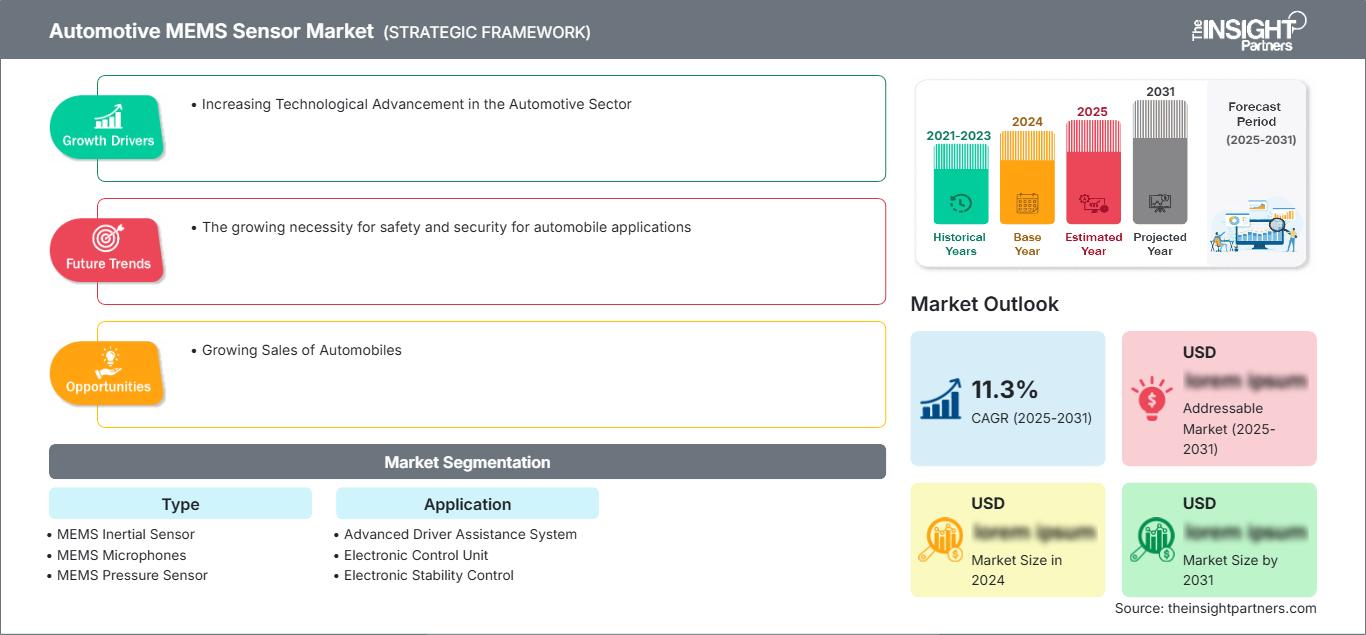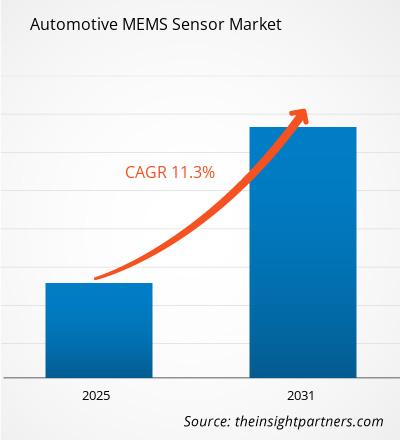Der Markt für Automotive-MEMS-Sensoren wird zwischen 2023 und 2031 voraussichtlich eine durchschnittliche jährliche Wachstumsrate (CAGR) von 11,3 % verzeichnen. Die Entwicklung fortschrittlicher Technologien und die Einführung hochwertiger Fahrzeuge werden voraussichtlich weiterhin ein wichtiger Markttrend bleiben.
Marktanalyse für MEMS-Sensoren in der Automobilindustrie
- Der Markt für MEMS-Sensoren in der Automobilindustrie wächst stetig aufgrund von Faktoren wie der steigenden Fahrzeugproduktion, der gestiegenen Nachfrage nach Sicherheitsfunktionen sowie Fortschritten in Technologie und Design.
- Die Integration miniaturisierter mechanischer und elektrischer Komponenten revolutioniert die Automobilindustrie, und der globale Automobilmarkt ist führend in Sachen Innovation.
- Moderne Fahrzeuge sind fast vollständig auf MEMS-Sensoren angewiesen, um wichtige Informationen für die Umweltüberwachung, die Fahrzeugsicherheit und Fahrerassistenzsysteme (ADAS) zu liefern.
- Der anhaltende Fokus der Automobilindustrie auf Effizienz, Sicherheit und Konnektivität wird voraussichtlich zu einem exponentiellen Wachstum der Nachfrage nach MEMS-Bauelementen führen und damit die Automobiltechnologielandschaft verändern.
Marktübersicht für MEMS-Sensoren in der Automobilindustrie
- Die Nachfrage nach MEMS-Sensoren in der Automobilindustrie ist aufgrund der wachsenden Anforderungen an Sicherheit und Schutz in der Automobilindustrie stark gestiegen. Anwendungen.
- MEMS-Sensoren nutzen Technologien, die typischerweise in sehr kleinen Geräten zu finden sind; sie werden auch als Mikromaschinen bezeichnet. MEMS-Sensoren bieten zahlreiche Vorteile für die Automobilbranche.
- Die Integration von MEMS-Sensoren bietet ein breites Spektrum potenzieller Anwendungen, darunter Unfallerkennung, Überschlagserkennung und Fahrzeugnavigationssysteme. Es wird erwartet, dass Hersteller elektronischer Komponenten und Autoteile von MEMS-Sensoren für die Automobilindustrie beeinflusst werden.
- Um die MEMS-Sensorindustrie für die Automobilindustrie zu unterstützen, sind nationale Regierungen auch sehr an der Entwicklung von Standards und Gesetzen interessiert.
- Darüber hinaus wächst der Markt aufgrund der Beliebtheit von Elektrofahrzeugen, der Nachfrage nach Gyroskopen sowie der Forschung und Entwicklung neuer MEMS-Sensoren erheblich.
Passen Sie diesen Bericht Ihren Anforderungen an
Sie erhalten kostenlos Anpassungen an jedem Bericht, einschließlich Teilen dieses Berichts oder einer Analyse auf Länderebene, eines Excel-Datenpakets sowie tolle Angebote und Rabatte für Start-ups und Universitäten.
Markt für MEMS-Sensoren für die Automobilindustrie: Strategische Einblicke

-
Holen Sie sich die wichtigsten Markttrends aus diesem Bericht.Dieses KOSTENLOSE Beispiel umfasst Datenanalysen, die von Markttrends bis hin zu Schätzungen und Prognosen reichen.
- Der Markt für MEMS-Sensoren wird von der Automobilindustrie getrieben.
- MEMS-Sensoren spielen eine Schlüsselrolle in Fahrerassistenzsystemen (ADAS), die Funktionen wie adaptive Geschwindigkeitsregelung, Kollisionsvermeidung und Spurhalteassistent umfassen.
- Diese Sensoren verbessern die Fahrsicherheit und das Fahrerlebnis, indem sie genaue Messungen der Fahrzeugbewegung und der Umgebung ermöglichen.
- Darüber hinaus erfordert die Entwicklung autonomer Fahrzeuge eine breite Palette von Sensoren für die Fahrzeugsteuerung, Hinderniserkennung und Navigation.
- MEMS-Sensoren sind in dieser Branche sehr gefragt, da die Automobilhersteller nach sichererem und autonomerem Fahren streben.
Der wachsende Bedarf an Sicherheit und Schutz für Automobilanwendungen
- Urbanisierung, steigende verfügbare Einkommen in Entwicklungsländern sowie technologischer Fortschritt und Leistungsfähigkeit treiben das Wachstum der Automobilindustrie deutlich voran.
- Zunehmender Fokus der Verbraucher auf Sicherheit Es wird erwartet, dass Funktionen in Personen- oder Nutzfahrzeugen die Wachstumschancen des Marktes für MEMS-Sensoren für Kraftfahrzeuge weltweit vorantreiben.
Segmentierungsanalyse des Marktberichts für MEMS-Sensoren für Kraftfahrzeuge
Schlüsselsegmente, die zur Ableitung der Marktanalyse für MEMS-Sensoren für Kraftfahrzeuge beigetragen haben, sind Produkttyp und Anwendung.
- Basierend auf dem Typ besteht der Markt für MEMS-Sensoren für Kraftfahrzeuge aus MEMS-Trägheitssensoren, MEMS-Mikrofonen und MEMS-Drucksensoren.
- Basierend auf der Anwendung ist der Markt für MEMS-Sensoren für Kraftfahrzeuge in fortschrittliche Fahrerassistenzsysteme, elektronische Steuergeräte, elektronische Stabilitätskontrollen, Heizungs-, Lüftungs- und Klimaanlagen, Sicherheit und Schutz, Fahrzeugnavigation, OIS-Kameras, Mikrofone in der Kabine, Reifendrucküberwachungssysteme und andere unterteilt.
Marktanteilsanalyse für MEMS-Sensoren für Kraftfahrzeuge nach Geografie
- Der Marktbericht für MEMS-Sensoren für Kraftfahrzeuge umfasst eine detaillierte Analyse von fünf großen geografischen Regionen, die die aktuelle und historische Marktgröße sowie Prognosen für 2021 bis 2031 umfasst und Nordamerika abdeckt. Europa, Asien-Pazifik (APAC), Naher Osten und Afrika (MEA) sowie Süd- und Mittelamerika.
- Jede Region ist weiter in entsprechende Länder unterteilt. Dieser Bericht bietet Analysen und Prognosen für mehr als 18 Länder und deckt die Marktdynamik von MEMS-Sensoren für die Automobilindustrie ab, wie z. B. Treiber, Trends und Chancen, die die Märkte auf regionaler Ebene beeinflussen.
- Darüber hinaus umfasst der Bericht eine PEST-Analyse, die die Untersuchung der wichtigsten Faktoren umfasst, die den Markt für MEMS-Sensoren für die Automobilindustrie in diesen Regionen beeinflussen.
MEMS-Sensoren für die Automobilindustrie
Regionale Einblicke in den Markt für MEMS-Sensoren für die AutomobilindustrieDie Analysten von The Insight Partners haben die regionalen Trends und Faktoren, die den Markt für Automotive-MEMS-Sensoren im Prognosezeitraum beeinflussen, ausführlich erläutert. In diesem Abschnitt werden auch die Marktsegmente und die geografische Lage in Nordamerika, Europa, im asiatisch-pazifischen Raum, im Nahen Osten und Afrika sowie in Süd- und Mittelamerika erörtert.
Umfang des Marktberichts für MEMS-Sensoren im Automobilbereich
| Berichtsattribut | Einzelheiten |
|---|---|
| Marktgröße in 2024 | US$ XX million |
| Marktgröße nach 2031 | US$ XX Million |
| Globale CAGR (2025 - 2031) | 11.3% |
| Historische Daten | 2021-2023 |
| Prognosezeitraum | 2025-2031 |
| Abgedeckte Segmente |
By Typ
|
| Abgedeckte Regionen und Länder |
Nordamerika
|
| Marktführer und wichtige Unternehmensprofile |
|
Dichte der Marktteilnehmer für MEMS-Sensoren im Automobilbereich: Auswirkungen auf die Geschäftsdynamik verstehen
Der Markt für MEMS-Sensoren für die Automobilindustrie wächst rasant. Dies wird durch die steigende Nachfrage der Endverbraucher aufgrund veränderter Verbraucherpräferenzen, technologischer Fortschritte und eines stärkeren Bewusstseins für die Produktvorteile vorangetrieben. Mit der steigenden Nachfrage erweitern Unternehmen ihr Angebot, entwickeln Innovationen, um den Bedürfnissen der Verbraucher gerecht zu werden, und nutzen neue Trends, was das Marktwachstum weiter ankurbelt.

- Holen Sie sich die Markt für MEMS-Sensoren für die Automobilindustrie Übersicht der wichtigsten Akteure
Der Markt für MEMS-Sensoren in der Automobilindustrie wird durch die Erhebung qualitativer und quantitativer Daten aus Primär- und Sekundärforschung bewertet, die wichtige Unternehmenspublikationen, Verbandsdaten und Datenbanken umfasst. Einige der Entwicklungen auf dem Markt für MEMS-Sensoren in der Automobilindustrie sind nachfolgend aufgeführt:
- MicroVision, Inc., ein führender Anbieter von MEMS-basierten Solid-State-Lidar- und Fahrerassistenzsystemen (ADAS)-Lösungen für die Automobilindustrie, gab bekannt, dass sein dynamisches View-Lidar-System MAVIN DR jetzt auf der NVIDIA DRIVE AGX-Plattform unterstützt wird. (Quelle: MicroVision, Inc., Unternehmenswebsite, September 2023)
- Die TDK Corporation hat das InvenSense Product Longevity Program (PLP) angekündigt, das die langfristige Verfügbarkeit von Hochleistungssensoren für Automobil- und Industrieanwendungen sicherstellt. Dieses Programm gilt für alle SmartIndustrial™-Komponenten und alle neu eingeführten SmartAutomotive™-Komponenten. Es zielt auf Branchen mit langen Designzyklen und langer Betriebsdauer ab und garantiert OEMs eine nachhaltige, langfristige Herstellung ihrer Produkte. (Quelle: TDK InvenSense, Pressemitteilung, Februar 2022)
Bericht zum Markt für MEMS-Sensoren für die Automobilindustrie: Abdeckung und Ergebnisse
Der „Marktbericht zu Größe und Prognose von MEMS-Sensoren für die Automobilindustrie (2021–2031)“ Der Bericht bietet eine detaillierte Analyse des Marktes und deckt die folgenden Bereiche ab:
- Marktgröße und Prognose für MEMS-Sensoren für die Automobilindustrie auf globaler, regionaler und Länderebene für alle abgedeckten wichtigen Marktsegmente
- Markttrends und Marktdynamiken für MEMS-Sensoren für die Automobilindustrie wie Treiber, Einschränkungen und wichtige Chancen
- Detaillierte PEST/Porters Five Forces- und SWOT-Analyse
- Marktanalyse für MEMS-Sensoren für die Automobilindustrie, die wichtige Markttrends, globale und regionale Rahmenbedingungen, wichtige Akteure, Vorschriften und aktuelle Marktentwicklungen umfasst
- Branchenlandschaft und Wettbewerbsanalyse, die Marktkonzentration, Heatmap-Analyse, prominente Akteure und aktuelle Entwicklungen auf dem Markt für MEMS-Sensoren für die Automobilindustrie umfasst
- Detaillierte Unternehmensprofile
- Historische Analyse (2 Jahre), Basisjahr, Prognose (7 Jahre) mit CAGR
- PEST- und SWOT-Analyse
- Marktgröße Wert/Volumen – Global, Regional, Land
- Branchen- und Wettbewerbslandschaft
- Excel-Datensatz
Aktuelle Berichte
Verwandte Berichte
Erfahrungsberichte
Grund zum Kauf
- Fundierte Entscheidungsfindung
- Marktdynamik verstehen
- Wettbewerbsanalyse
- Kundeneinblicke
- Marktprognosen
- Risikominimierung
- Strategische Planung
- Investitionsbegründung
- Identifizierung neuer Märkte
- Verbesserung von Marketingstrategien
- Steigerung der Betriebseffizienz
- Anpassung an regulatorische Trends






















 Kostenlose Probe anfordern für - Markt für MEMS-Sensoren für die Automobilindustrie
Kostenlose Probe anfordern für - Markt für MEMS-Sensoren für die Automobilindustrie